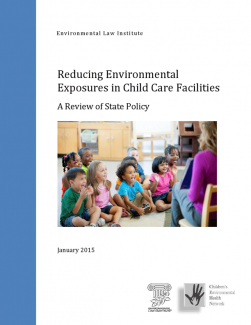
This report, prepared by ELI and the Children’s Environmental Health Network, provides an overview of how state policies and programs address indoor air quality in the child care setting.
All 50 states, along with many tribal and local jurisdictions, have licensing rules governing certain types of child care facilities, and many states update their child care licensing rules on a frequent or regular basis. Child care licensing rules typically include at least some standards and requirements governing the physical environment of the facility, though such provisions vary considerably. States may also have separate laws and rules that address specific environmental health issues, such as smoking, radon, or carbon monoxide, in the child care setting.
Overview of the Report
Separate chapters of the report discuss state laws, regulations, and non-regulatory initiatives on the following indoor environmental issues: Environmental Tobacco Smoke, Radon, Carbon Monoxide Alarms, Mold and Dampness, Building Ventilation and Temperature, Pesticides, Lead-Based Paint, Asbestos, Other Chemical Exposures, and Facility Site/Location. The report notes the general prevalence of state policies on these issues and highlights numerous state examples, though it does not provide an exhaustive listing of all state policies and programs in effect at the time of publication. Following are some of the key findings from the report:
- All states prohibited or restricted smoking at child care facilities in some way, through smoke-free laws and/or child care regulations.
- A majority of states had child care or lead paint laws and regulations prohibiting lead paint hazards in child care facilities, and some of those policies require providers to take specific steps to address known or suspected lead hazards.
- A significant number of states addressed asbestos and mold directly, most commonly by prohibiting asbestos hazards and requiring premises to be free of mold or dampness.
- Ten states had adopted laws or regulations that require radon testing and/or mitigation in child care, and a majority of states had required installation of carbon monoxide alarms in some or all types of licensed child care facilities.
- A considerable number of state licensing rules included maximum indoor temperatures or other provisions for preventing excessive heat.
- The chemical exposures most frequently addressed in licensing rules were the use of cleaning products and pesticides, with many states restricting when and how those products may be used; a smaller number of states restricted the use of other products that pose chemical exposure risks.
Since the report’s publication in January 2015, states have continued to adopt child care policies on these IAQ issues. Wisconsin and Delaware are examples of additional states that established radon testing and mitigation requirements. Washington and Colorado amended state rules to prohibit the use of air fresheners and other scent-enhanced products, while Oregon revised its rules to require child care centers to take steps to prevent exposure to mold, asbestos, lead-based paint, and pesticides.
Explore other materials from ELI’s Indoor Environments Program.
© Environmental Law Institute®